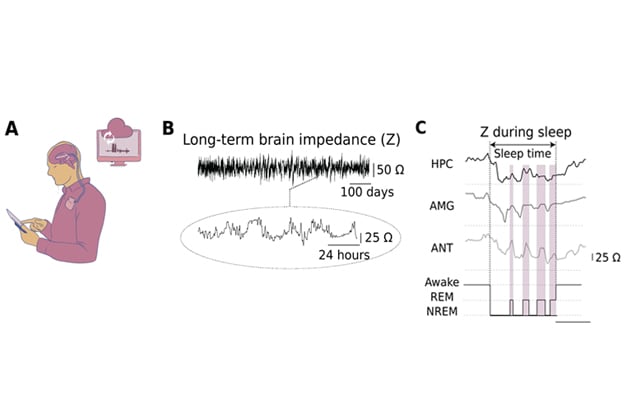Oct. 27, 2023
Impedance is a fundamental electrical property of brain tissue that is commonly treated as a constant. Mayo Clinic researchers have demonstrated that human brain impedance exhibits multiscale oscillations, spanning hours to months, that depend on sleep-wake behavioral cycles.
The findings — published in the September. 2023 issue of the Journal of Neuroscience — potentially can impact the forecasting of epileptic seizures as well as improve understanding of the brain glymphatic system's dependence on the sleep-wake cycle.
"We find that seizures tend to occur at specific times of the day and that impedance is higher on the days with seizures. We're currently investigating this phenomenon."
فيزيولوجيا كهربية الدماغ البشري وسلوكه

فيزيولوجيا كهربية الدماغ البشري وسلوكه
أ. قدَّم النظام التحققي بثًا لاسلكيًا مستمرًا لجهود الحقل الموضعي (LFPs) والمقاومة الكهربائية للدماغ (Z). يُمكِّن النظام الاتصالات المتزامنة ثنائية الأبعاد بين المريض، وأجهزة الاستشعار والتنبيه العصبي القابلة للزرع، والبنية الأساسية المحلية والموزعة للحوسبة السحابية. ب. مكَّن البث المستمر لجهود الحقل الموضعي للدماغ مراقبة النشاط الصرعي والمقاومة الكهربائية للدماغ. تُظهر الوليجة الارتفاع التلقائي للصرع بين النوبات واكتشافات نوبات الصرع. ج. سُجِّلت سلسلة زمنية تمثيلية للمقاومة الأولية في الحُصَين (HPC) واللوزة الدماغية (AMG) ونواة المهاد الأمامية (ANT). د. تُظهر المقاييس الزمنية الممتدة لمتوسط المقاومة الكهربائية للدماغ دورات مدتها 24 ساعة على مدار أيام وأسابيع متعددة.
A novel implanted investigational device wirelessly streamed brain activity from five individuals with drug-resistant focal epilepsy to local and cloud computing resources. Those resources enabled artificial intelligence to continuously track seizures, sleep-wake behavior and electrical impedance in the individuals over multiple months.
Key findings:
- Impedance in the amygdala, hippocampus and anterior nucleus thalamus exhibited multiscale cycles with ultradian, circadian and infradian periods.
- The ultradian and circadian period cycles were driven by sleep-wake state transitions.
- Impedance rose on average throughout the day during wakefulness, reaching a maximum in the evening before sleep and decreasing overnight to a minimum value in the early morning before awakening.
- The infradian period cycles weren't recognized to be associated with a distinct behavioral correlate.
Brain tissue impedance is known to depend strongly on extracellular space (ECS) volume: the space between brain cells that contains an interstitial fluid of ions, neurotransmitters and waste products. The vital role of ECS in the brain's glymphatic system has recently been recognized. The brain's glymphatic system, which is responsible for waste clearance, is essential for brain health.
The researchers propose that impedance oscillations reflect behavioral state-dependent ECS changes generated by the glymphatic system.
"Impedance is a simple electrophysiological biomarker that could prove useful for tracking ECS dynamics," says Gregory A. Worrell, M.D., Ph.D., a neurologist and leader of the Bioelectronics Neurophysiology and Engineering Laboratory at Mayo Clinic in Rochester, Minnesota. "Impedance oscillations will directly impact brain ionic current flow that underlie neurological functions and that affect therapeutic electrical brain stimulation and possibly brain health, through the brain glymphatic system."
The researchers suggest that the multiscale impedance cycles represent normal brain physiology. Impedance fluctuations on the days of seizures, which were excluded from analysis, showed impedance differences compared with days without seizures — suggesting that impedance might be a useful biomarker for tracking brain excitability and seizure risk.
"We find that seizures tend to occur at specific times of the day and that impedance is higher on the days with seizures," Dr. Worell says. "We're currently investigating this phenomenon. But it suggests that epileptic brain impedance may be changed at baseline and vary with seizure risk."
The research is funded by the National Institutes of Health Brain Research Through Advancing Innovative Neurotechnologies (BRAIN) Initiative. The study is the first to analyze continuous sampling of human intracranial brain impedance and electrophysiology over multiple months.
For more information
Mivalt F, et al. Impedance rhythms in human limbic system. The Journal of Neuroscience. 2023;43:6653.
Bioelectronics Neurophysiology and Engineering Laboratory: Gregory A. Worrell. Mayo Clinic.
Refer a patient to Mayo Clinic.